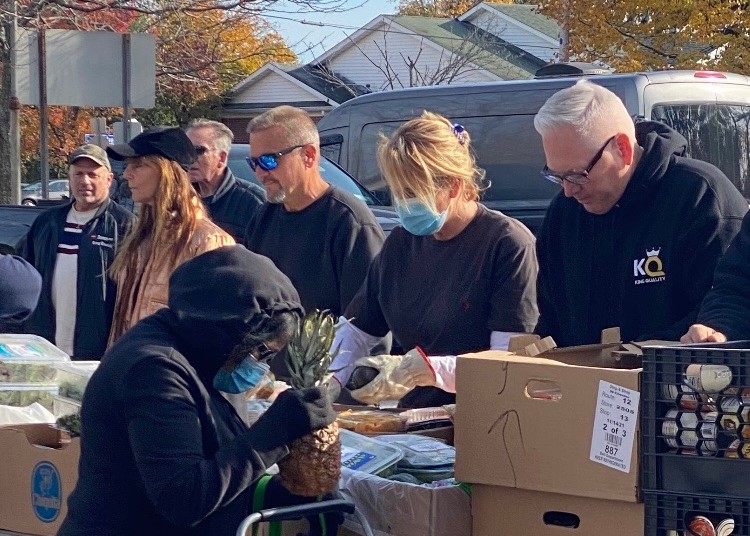Just a few weeks before Thanksgiving, Pastor Jim Ryan, president of Lighthouse Mission, a mobile food pantry based in Bellport, was unsure how he’d secure hundreds of turkeys to feed families in need this year — but just knew that they’d somehow find a way.
With inflation sending grocery prices soaring, Ryan estimated it would cost $27,000 to bring 150 turkeys to each of Lighthouse Mission’s 10 outreach locations in Suffolk County. The nonprofit has seen a drop in individual donations recently, which it relies on to supply families with groceries five days a week, every week.
“Since donations are down, we’re finding that at the same time, the need has gone up,” Ryan says. “A lot of the time, the people that were giving are now on the other side of the line and are in need.”
The Christian organization is not affiliated with a church or any particular denomination, nor does it take government funding, so donations are sorely needed. Still, its leaders and volunteers have not lost faith that they will continue providing for their communities.
“We just trust in God,” Ryan says, “and he comes through.”
Nonprofits, especially small ones like Lighthouse Mission, are faring slightly better than when the pandemic began. Many who do receive government assistance have relied on CARES Act Funding to get them through the past year, says Ken Cerini, managing partner of Cerini & Associates, LLP, a Bohemia-based accounting firm that serves nonprofits and releases its Nonprofit Update report annually.
“As this money dries up as we go into 2022, organizations will find themselves at a crossroads if the pandemic continues to linger,” Cerini says. “For the most part, 2021 has seen some rebound from last year, but it has still been a difficult year for nonprofit organizations.”
In a typical year, small nonprofits rely on large fundraising events, like golf outings and galas, and individual donations. But because many people are still hesitant to return to big gatherings, and the region as a whole struggles financially due to Covid, individual donations have decreased over the past two years.
Maureen’s Haven, a Riverhead-based nonprofit focused on homeless outreach programs, receives less than 14 percent of its revenue from state and federal funding. The rest is largely from donations and fundraising events.
“We usually rely on our gala,” says Dan O’Shea, executive director of Maureen’s Haven. “Now is still not the time to get 150 people in a room.”
To make up for losses in revenue, nonprofits have had to get creative. First, they’ve had to find new ways to raise money.
“It’s been a lot of additional grant writing and making requests to past donors to try and offset that,” O’Shea says, noting that the organization has needed to shift where it spends its money because of new fundraising initiatives.

Nonprofits have also rediscovered the importance of partnering with friends in the community.
The needs of homeless individuals vary widely, and Maureen’s Haven may not always have the items they need at the ready, such as specific clothing, like T-shirts, boots, or sneakers, or necessities such as toilet paper. To meet these needs, the organization often reaches out to local places of worship and civic associations that can get donations from their members.
“We’ve been around since 2002, we serve both [the North and South Fork], and we’re well established with those communities,” O’Shea says. “It’s important we keep those donors and volunteers engaged.”
Engagement means partnering with the community for small events and initiatives and making sure the organization remains on the radar of people and businesses who will be inclined to donate in the future. But this isn’t always easy, due to shortages in staff that are usually behind such projects.
“Nonprofits, like everyone else, are finding it increasingly difficult to find staff, especially at lower salary ranges,” Cerini says. “This has been exacerbated by mandatory vaccination requirements. Add to this that nonprofits tend to pay less than other employers, so many nonprofits have seen a loss of staff to their for-profit counterparts.”
Because of this, Cerini foresees nonprofit partnerships going a step further in the future.
“We expect to see an uptick in collaborations and mergers within the sector over the next five years,” he says.
Ultimately, the generosity of Long Island families and companies who are able to help keeps small nonprofits helping the region’s most vulnerable.
“We did see some donors who were a little extra generous this year,” O’Shea says. “Typically, the end of the year is one of our busiest times when it comes to funds — [November and December] are our two largest months for donations.”
Getting the message out to businesses that are in a position to donate could be key to nonprofits going forward because consumers care more about a company’s social impact nowadays, Cerini says. Last year, Cerini predicted corporate giving would increase 1.4% in 2021. His office will release a new report about nonprofit finances in January.
“Donations from businesses have always been one of the small areas of contributions for the nonprofit sector,” he said during a recent webinar, “but corporate giving is predicted to increase … because of that new need for social responsibility in business.”
When it came to Thanksgiving this year, the generosity of a local business helped fuel Lighthouse Mission’s turkey drive for its recipients.
King Quality, a Bohemia-based roofing, windows and siding company, donated 150 turkeys and Thanksgiving meal sides at Lighthouse Mission’s outreach location in Central Islip, helping the organization cut down on costs to feed others.
“Being able to partner with Lighthouse Mission this Thanksgiving to help feed our Long Island neighbors fills me with joy and also with hope,” says King Quality CEO Jeff Brett. “I’ve lived on Long Island all my life and while it’s one of the most affluent parts in America, hunger is a reality here for a lot of people and it’s especially tough to be alone and hungry during the holidays.”
“The need is going up,” Ryan says. “Not everybody believes how much of a need there is. The need is going up, but donations are going down. I know how hard it is out there. We get that.”
Ryan often asks the public for “much-needed funds” on Facebook — but remains steadfast in his confidence that donors will come through.
Sign up for Long Island Press’ email newsletters here. Sign up for home delivery of Long Island Press here. Sign up for discounts by becoming a Long Island Press community partner here.




























